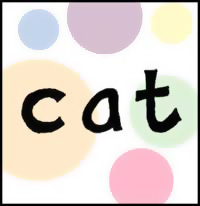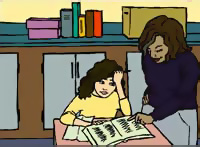What components comprise high-quality reading instruction?
Page 5: Phonics and Word Study
 The term phonics instruction refers to teaching students about the relationship between sounds and written letters (known as the alphabetic principle) so that the students learn how to decode and read words. In word study instruction, students learn to use complex elements of reading to decode more advanced words (e.g., students learn how to decode words based on associated word meanings and by learning how to identify word parts, such as affixes and root words). The combination of phonics and word study helps students with word recognition, reading, and spelling.
The term phonics instruction refers to teaching students about the relationship between sounds and written letters (known as the alphabetic principle) so that the students learn how to decode and read words. In word study instruction, students learn to use complex elements of reading to decode more advanced words (e.g., students learn how to decode words based on associated word meanings and by learning how to identify word parts, such as affixes and root words). The combination of phonics and word study helps students with word recognition, reading, and spelling.
Why Should I Teach It?
The ability to sound out and recognize words is a major factor in text comprehension. More specifically, when students possess strong phonics and word study skills, they are able to translate written text into spoken words accurately and quickly. This allows students to concentrate on the purpose of reading: understanding the meaning of the text.
Research Shows
- When phonics instruction is delivered systematically and explicitly, students’ decoding skills are improved. Furthermore, students show greater growth in word study skills as the school year progresses.
(Foorman, et al., 1998) - Phonics instruction is most beneficial when it is initiated early in students’ education—preferably in kindergarten and first grade.
(Partnership for Reading, 2006a)
How Do I Teach It?
When Should I Teach It?
Phonics and word study instruction should begin by kindergarten or early first grade and continue through third grade and beyond.
When to begin phonics and word study instruction depends on the emerging development of students’ phonemic awareness skills. Typically, students learn letter-sound relationships before they move on to phonics instruction.
Phonics
 The ability of students to sound out printed words will unfold as teachers instruct them in the relationship between letters, sounds, and written language. It is best to begin teaching sound-to-print associations that are easiest for students to pronounce, read, and comprehend. Letters should be introduced so that students can quickly blend the sounds into words that they can read. For example, after s, m, t, and a have been introduced, students can read “am,” “Sam,” “at,” “sat,” and “mat.” For letters with more than one sound, teachers should first teach the more commonly used sound (e.g., the short “i” sound is used nearly twice as often in words as the long “i” sound).
The ability of students to sound out printed words will unfold as teachers instruct them in the relationship between letters, sounds, and written language. It is best to begin teaching sound-to-print associations that are easiest for students to pronounce, read, and comprehend. Letters should be introduced so that students can quickly blend the sounds into words that they can read. For example, after s, m, t, and a have been introduced, students can read “am,” “Sam,” “at,” “sat,” and “mat.” For letters with more than one sound, teachers should first teach the more commonly used sound (e.g., the short “i” sound is used nearly twice as often in words as the long “i” sound).
Teachers should begin phonics instruction by teaching letter-sound correspondences in a specific sequence, during which students learn to use these relationships to decode words. Phonics instruction includes teaching letter-sound combinations (e.g., the printed letters “t” and “h” together correspond to the sound /th/) and word patterns, such as consonant-vowel-consonant.
There are various ways to teach phonics instruction. See the table below for an example.
| Phonics Instruction | |||||||||
 |
|||||||||
| The use of word families is a systematic way for students to learn to categorize patterns. Students recognize that if they can read one member of a word family and blend other combinations then they can read many words sharing the same pattern. | |||||||||
 |
|
||||||||
Word Study
 Word study takes into account the more complex elements of reading, such as irregular words and word parts. Teachers should introduce and provide practice with some basic irregular words (e.g., “was,” “you“) so that students can begin to read simple text. Additionally, by understanding the different parts of words, students can increase their ability to decode. As students’ decoding skills progress, teachers should gradually introduce word parts (e.g., root words, prefixes, and suffixes) in order to help students better understand word meanings.
Word study takes into account the more complex elements of reading, such as irregular words and word parts. Teachers should introduce and provide practice with some basic irregular words (e.g., “was,” “you“) so that students can begin to read simple text. Additionally, by understanding the different parts of words, students can increase their ability to decode. As students’ decoding skills progress, teachers should gradually introduce word parts (e.g., root words, prefixes, and suffixes) in order to help students better understand word meanings.
There are various ways to teach word study instruction. See the table below for an example.
| Word Study Instruction | |||||||||||||||
 |
|||||||||||||||
 |
|
||||||||||||||
Phonics and word study instruction often overlap and should be delivered in a systematic format. Students should be given ample opportunities to practice phonics and word study skills through reading and writing. When spelling is used as part of phonics and word study lessons, teachers should connect spelling activities to phonics and decoding. For example, teachers can ask students to practice decoding words and spelling them aloud or instruct them to practice reading words and then defining them.
The table below offers some helpful hints for incorporating phonics and word study instruction.
| Tips for Teaching |
|